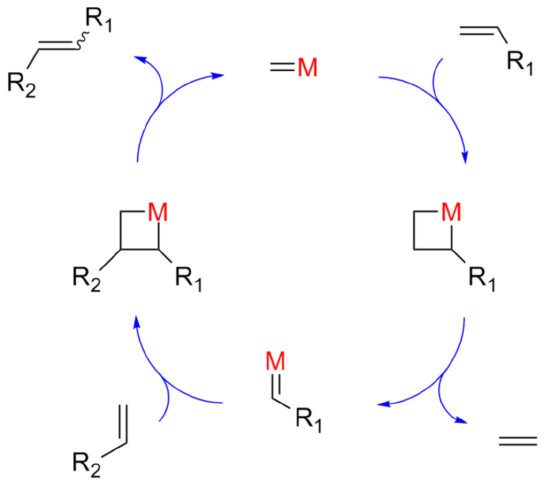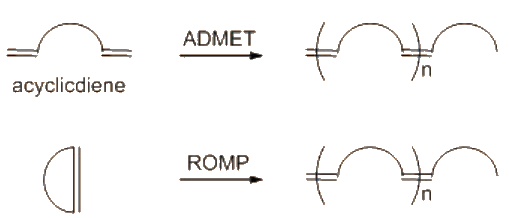30.5: Olefin Metathesis Polymerization
- Page ID
- 364615
\( \newcommand{\vecs}[1]{\overset { \scriptstyle \rightharpoonup} {\mathbf{#1}} } \)
\( \newcommand{\vecd}[1]{\overset{-\!-\!\rightharpoonup}{\vphantom{a}\smash {#1}}} \)
\( \newcommand{\id}{\mathrm{id}}\) \( \newcommand{\Span}{\mathrm{span}}\)
( \newcommand{\kernel}{\mathrm{null}\,}\) \( \newcommand{\range}{\mathrm{range}\,}\)
\( \newcommand{\RealPart}{\mathrm{Re}}\) \( \newcommand{\ImaginaryPart}{\mathrm{Im}}\)
\( \newcommand{\Argument}{\mathrm{Arg}}\) \( \newcommand{\norm}[1]{\| #1 \|}\)
\( \newcommand{\inner}[2]{\langle #1, #2 \rangle}\)
\( \newcommand{\Span}{\mathrm{span}}\)
\( \newcommand{\id}{\mathrm{id}}\)
\( \newcommand{\Span}{\mathrm{span}}\)
\( \newcommand{\kernel}{\mathrm{null}\,}\)
\( \newcommand{\range}{\mathrm{range}\,}\)
\( \newcommand{\RealPart}{\mathrm{Re}}\)
\( \newcommand{\ImaginaryPart}{\mathrm{Im}}\)
\( \newcommand{\Argument}{\mathrm{Arg}}\)
\( \newcommand{\norm}[1]{\| #1 \|}\)
\( \newcommand{\inner}[2]{\langle #1, #2 \rangle}\)
\( \newcommand{\Span}{\mathrm{span}}\) \( \newcommand{\AA}{\unicode[.8,0]{x212B}}\)
\( \newcommand{\vectorA}[1]{\vec{#1}} % arrow\)
\( \newcommand{\vectorAt}[1]{\vec{\text{#1}}} % arrow\)
\( \newcommand{\vectorB}[1]{\overset { \scriptstyle \rightharpoonup} {\mathbf{#1}} } \)
\( \newcommand{\vectorC}[1]{\textbf{#1}} \)
\( \newcommand{\vectorD}[1]{\overrightarrow{#1}} \)
\( \newcommand{\vectorDt}[1]{\overrightarrow{\text{#1}}} \)
\( \newcommand{\vectE}[1]{\overset{-\!-\!\rightharpoonup}{\vphantom{a}\smash{\mathbf {#1}}}} \)
\( \newcommand{\vecs}[1]{\overset { \scriptstyle \rightharpoonup} {\mathbf{#1}} } \)
\( \newcommand{\vecd}[1]{\overset{-\!-\!\rightharpoonup}{\vphantom{a}\smash {#1}}} \)
\(\newcommand{\avec}{\mathbf a}\) \(\newcommand{\bvec}{\mathbf b}\) \(\newcommand{\cvec}{\mathbf c}\) \(\newcommand{\dvec}{\mathbf d}\) \(\newcommand{\dtil}{\widetilde{\mathbf d}}\) \(\newcommand{\evec}{\mathbf e}\) \(\newcommand{\fvec}{\mathbf f}\) \(\newcommand{\nvec}{\mathbf n}\) \(\newcommand{\pvec}{\mathbf p}\) \(\newcommand{\qvec}{\mathbf q}\) \(\newcommand{\svec}{\mathbf s}\) \(\newcommand{\tvec}{\mathbf t}\) \(\newcommand{\uvec}{\mathbf u}\) \(\newcommand{\vvec}{\mathbf v}\) \(\newcommand{\wvec}{\mathbf w}\) \(\newcommand{\xvec}{\mathbf x}\) \(\newcommand{\yvec}{\mathbf y}\) \(\newcommand{\zvec}{\mathbf z}\) \(\newcommand{\rvec}{\mathbf r}\) \(\newcommand{\mvec}{\mathbf m}\) \(\newcommand{\zerovec}{\mathbf 0}\) \(\newcommand{\onevec}{\mathbf 1}\) \(\newcommand{\real}{\mathbb R}\) \(\newcommand{\twovec}[2]{\left[\begin{array}{r}#1 \\ #2 \end{array}\right]}\) \(\newcommand{\ctwovec}[2]{\left[\begin{array}{c}#1 \\ #2 \end{array}\right]}\) \(\newcommand{\threevec}[3]{\left[\begin{array}{r}#1 \\ #2 \\ #3 \end{array}\right]}\) \(\newcommand{\cthreevec}[3]{\left[\begin{array}{c}#1 \\ #2 \\ #3 \end{array}\right]}\) \(\newcommand{\fourvec}[4]{\left[\begin{array}{r}#1 \\ #2 \\ #3 \\ #4 \end{array}\right]}\) \(\newcommand{\cfourvec}[4]{\left[\begin{array}{c}#1 \\ #2 \\ #3 \\ #4 \end{array}\right]}\) \(\newcommand{\fivevec}[5]{\left[\begin{array}{r}#1 \\ #2 \\ #3 \\ #4 \\ #5 \\ \end{array}\right]}\) \(\newcommand{\cfivevec}[5]{\left[\begin{array}{c}#1 \\ #2 \\ #3 \\ #4 \\ #5 \\ \end{array}\right]}\) \(\newcommand{\mattwo}[4]{\left[\begin{array}{rr}#1 \amp #2 \\ #3 \amp #4 \\ \end{array}\right]}\) \(\newcommand{\laspan}[1]{\text{Span}\{#1\}}\) \(\newcommand{\bcal}{\cal B}\) \(\newcommand{\ccal}{\cal C}\) \(\newcommand{\scal}{\cal S}\) \(\newcommand{\wcal}{\cal W}\) \(\newcommand{\ecal}{\cal E}\) \(\newcommand{\coords}[2]{\left\{#1\right\}_{#2}}\) \(\newcommand{\gray}[1]{\color{gray}{#1}}\) \(\newcommand{\lgray}[1]{\color{lightgray}{#1}}\) \(\newcommand{\rank}{\operatorname{rank}}\) \(\newcommand{\row}{\text{Row}}\) \(\newcommand{\col}{\text{Col}}\) \(\renewcommand{\row}{\text{Row}}\) \(\newcommand{\nul}{\text{Nul}}\) \(\newcommand{\var}{\text{Var}}\) \(\newcommand{\corr}{\text{corr}}\) \(\newcommand{\len}[1]{\left|#1\right|}\) \(\newcommand{\bbar}{\overline{\bvec}}\) \(\newcommand{\bhat}{\widehat{\bvec}}\) \(\newcommand{\bperp}{\bvec^\perp}\) \(\newcommand{\xhat}{\widehat{\xvec}}\) \(\newcommand{\vhat}{\widehat{\vvec}}\) \(\newcommand{\uhat}{\widehat{\uvec}}\) \(\newcommand{\what}{\widehat{\wvec}}\) \(\newcommand{\Sighat}{\widehat{\Sigma}}\) \(\newcommand{\lt}{<}\) \(\newcommand{\gt}{>}\) \(\newcommand{\amp}{&}\) \(\definecolor{fillinmathshade}{gray}{0.9}\)Olefin Metathesis
The application of organometallic chemistry in homogenous catalysis is progressively increasing with the fast pace of discovery of new catalysts in the area. Alkene metathesis reactions are gaining wide popularity in synthesizing unsaturated olefinic compounds. Central to this catalysis is a metal carbene intermediate that reacts with olefins to give different olefinic compounds. When two different olefin substrates are used, the reaction is called the “cross metathesis” owing to the fact that the olefinic ends are exchanged. In a process called olefin metathesis polymerization, unsaturated olefinic polymers can be created by a metathesis reaction.

Olefin metathesis catalysts contain a metal carbon double bond with two of the most notable being are the Grubbs Ru catalyst and the Schrock’s Mo catalyst.

Mechanism Cross Metathesis
An olefin metathesis catalyst is a transition metal compound that is capable of splitting the double bond of an alkene in half and putting the two pieces together with other alkenes. The key part of an olefin metathesis catalyst is a metal-carbon double bond. That is the group that is capable of switching the ends of alkenes around with different partners. The catalyst react reversibly with an alkene to produce a 4−membered metalacyclobutane intermediate called a metallacycle. The ring promptly opens to produce a different catalyst and alkene. The reaction of this new catalyst with the second alkene produces a second metallacycle intermediate. This ring opens to produce the metathesis product and yet another form of the catalyst. The ring opening and closing continues as the reaction moves forward.

Olefin Metathesis Polymerization The variants of metathesis often used in producing polymers are: (i) the Acyclic Diene Metathesis (ADMET) and (ii) the Ring Opening Metathesis Polymerization (ROMP), both of which produce long chain polymers

One method, called ring-opening metathesis polymerization, or ROMP, involves the use of a moderately strained cycloalkene, such as cyclopentene. The strain of the ring favors ring-opening, thereby driving formation of the open-chain product. The polymer that results has double bonds spaced regularly along the chain, allowing for either hydrogenation or further functionalization if desired.
Ring-opening metathesis polymerization (ROMP) takes a cyclic alkene, splits open its double bond, and knitting it together with other cyclic alkenes to produce a long polymer chain with regularly spaced double bonds. The ring-strain of the cycloalkenes favors the open-chain product and drives the polymerization reaction forward.
During a ROMP, a cyclopentene ring is opened up at the double bond and reaches out to join with other cyclopentene rings on either side of it.

The product polymer of a ROMP using cyclopentene rings would look something like this:

Which can draw it in an usual zig-zag conformation.

Mechanism
The mechanism starts with a cycloalkene and a metathesis catalyst reacting to form a four-member metallacycle. Opening of the metallacycle forms a new alkene and catalyst both of which are part of the same intermediate molecule. The catalyst end of the intermediate molecule can then react with a different cycloalkene to form a new metallacycle. This process is repeated causing the polymer chain to from.

The second method is called acyclic diene metathesis (ADMET) which uses long open-chain substrates, which contain a double bond at both ends of the main chain, such as 1,6-heptadiene. A byproduct of the reaction, gaseous ethylene (H2C=CH2), escapes which drives the equilibrium forward.

The ring opening metathesis polymerization of norborene produces a commercial polymer called Norsore which is used a sealing material. Please draw the structure of Norsore.
- Answer
-

